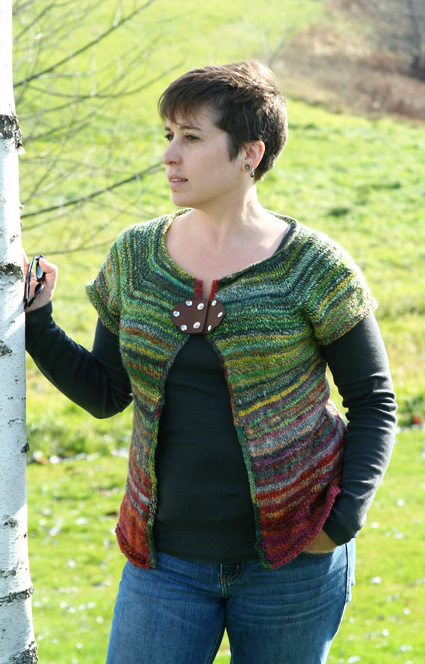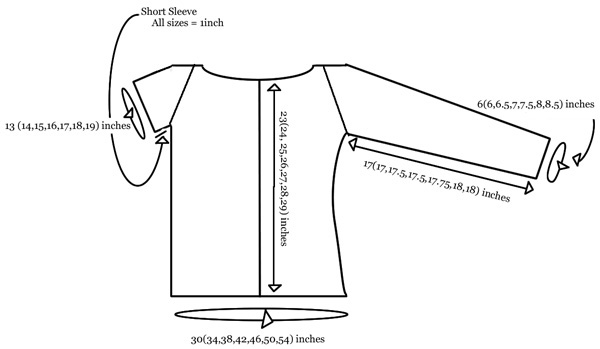

|
|
|

I belong to a couple of spinning clubs and before a larger option was available, 4 ounces was all you'd get of any fiber. Sometimes I have been shopping at a fair and 4 ounces of a handpainted top was all that was available but I had to have it anyway. |
||
|
|
 |
Tweet
|
|
SIZE |
|
|
FINISHED MEASUREMENTS |
|
MATERIALS
Yarns C1, C2 and C4 were spun by Amy King. Tools |
|||||
|
GAUGE |
| 18 sts/24 rows = 4" in stockinette stitch |
|
PATTERN NOTES |
|
The handspun sweater shown at the top was knit without body shaping because it has negative ease and I planned to only use a clasp at the chest. The handpainted sweater at right uses the body shaping as described.
Please see the article for the color before choosing your yarn if you're unsure of the colors and you're working the color shifts. Fit: If you're choosing to make the sweater with one button to be used up at the chest, I recommend it have just a little negative ease. It makes the sweater fit a little better. If you are making the sweater to button all the way down, it will look better with neutral or a little bit of ease. The measurements are there for you to decide how you prefer your sweater to fit. Color shifting pattern If you want a longer sweater, there are 3 options. |
|
DIRECTIONS Rep Rows 9 and 10 21[23, 25, 26, 29, 32, 35] times. 239[271, 309, 343, 373, 397, 427] sts. 168[184, 200, 208, 232, 256, 280] sts increased. Sweater should measure approx. 7.5[8.25, 8.75, 9.25, 10.25, 11.25, 12.25] inches from bottom of rolled hem. You should have 34[38, 43, 47, 52, 56, 61] sts each for right and left fronts, 52[59, 69, 77, 83, 86, 92] sts each for right and left sleeves, and 67[77, 85, 95, 103, 113, 121] sts for back. Divide body and sleeves: Make a note of which row you have reached in the color shift pattern so that you are able to resume on the correct row when you begin working the sleeves. With the sleeves now on holders, continue to work in st st in the color shift pattern as described. If working sweater with neutral or positive ease: work waist shaping as follows: Rep Rows 2-5 once more. 123[141, 159, 177, 195, 213, 231] sts. 4 sts decreased. Work 2[2, 2.5, 2.5, 3, 3, 3.5] inches even in st st ending on a WS row. Next row [RS]: *K to 1 st before first marker, M1, k1, SM, k1, M1; rep from * once more; k to end of the row. 127[145, 163, 181, 199, 217, 235] sts. 4 sts increased. Work 5 rows even in st st. Next row [RS]: *K to 1 st before first marker, M1, k1, SM, k1, M1; rep from * once more; k to end of the row. 131[149, 167, 185, 203, 221, 239] sts. 4 sts increased. Rep last 6 rows one more time. 135[153, 171, 189, 207, 225, 243] sts. 4 sts increased. Work even in st st until all color shift pattern repeats have been worked and front measures 22[23, 24, 25, 26, 27, 28] inches from cast-on edge. Short Sleeves: Using the color you were using at the point you divided for body and sleeves, pick up all the stitches. 52[59, 69, 77, 83, 86, 92] sts. Work 8 rounds even. BO all sts very loosely. Longer sleeves: Using the color you were using at the point you divided for body and sleeves, pick up all the stitches, PM at the underarm before joining into the round. 52[59, 69, 77, 83, 86, 92] sts. Work Decrease rnd every 8[6, 5, 5, 4, 4, 4] rounds 11[15, 19, 21, 23, 24, 26] times. |
|
FINISHING Rep for other side of sweater, beginning by picking up the 6th st from top of front top left edge of sweater. Note: I like to add in an extra row in the I-cord every 10 rows or so to make sure it's not too tight. This is because I tend to knit my I-cord a little tight to make it roll nicer, so my row gauge on the I-cord is slightly different than the sweater. If your row gauge is the same and it looks good, then just knit one row of I-cord for each row of the sweater. Weave in those last ends and block to size. The handspun sweater is closed with a shawl pin or a Jul snap. The long-sleeved fully closed sweater uses a zipper for the final closure. |
 |
| ABOUT THE DESIGNER |
|
Amy lives in a small town in Maine where she homeschools her kids and runs Spunky Eclectic Spinning and Weaving shop. Designing for knitwear and weaving is a passion. |
|
Pattern & images © 2012 Amy King. Contact Amy |